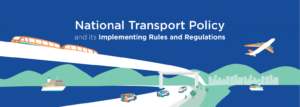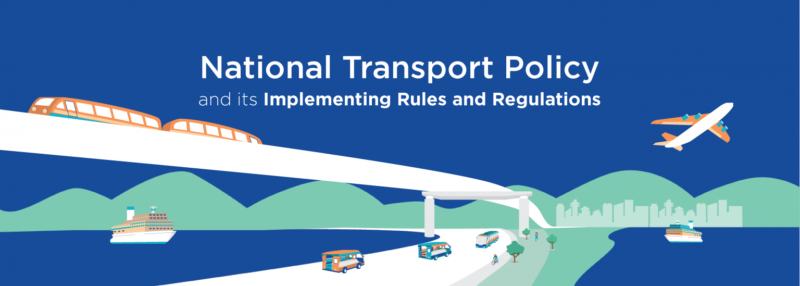
The National Economic and Development Authority (NEDA) has released implementing rules and regulations (IRR) of the National Transport Policy (NTP), the policy that embodies the government’s intended reforms in the transport sector.
Among policies pushed under the IRR are the use of ports outside Metro Manila, provision of alternative truck routes, harmonization of traffic ordinances, and establishment of a seamless intermodal transport logistics network.
The IRR sets the direction and parameters of the integrated development and regulation of the Philippine transport sector pursuant to the NTP, which was adopted by the NEDA Board in June 2017. The IRR took effect last January 14, 2020 after it was announced in a general circulation publication on December 30, 2019.
The NTP was formulated to help achieve the government’s vision of a “safe, secure, reliable, efficient, integrated, intermodal, affordable, cost-effective, environmentally sustainable, and people-oriented national transport system that ensures improved quality of life of the people,” according to NEDA.
It noted that the absence of a single encompassing policy document for the transport sector has manifested recurring challenges, including the lack of an integrated and coordinated transport network; overlapping and conflict of the functions of transport agencies; transport safety and security concerns; and inadequate transport facilities particularly in conflict-affected and underdeveloped areas.
The authority noted that until legislative policies are passed, policy changes and reforms that can be administratively undertaken under existing laws need to be adopted and implemented to be able to respond to the urgent transport demands and requirements of the national economy.
The NTP IRR applies to all elements of the transportation system and all its sub-sectors, including passengers, operators, service providers, investors, and transport-related agencies and instrumentalities of government, as well as to those involving the movement of people, goods, and services, and the provision of transport infrastructure, facilities and services.
The IRR should also be observed and used as a guide in transport planning, development, implementation, management, and operations.
Under the IRR, the NEDA Board Committee on Infrastructure, through its transport planning arm, Inter-Agency Technical Committee on Transport Planning, should, consistent with the government’s planning cycle, periodically identify, review, and address the strategic resource needs of the transport sector for the short, medium, and long term, including the assessment of the previous fiscal allocation or cost-sharing.
It noted that in assessing people’s needs and reviewing government interventions, the inputs of stakeholders and target beneficiaries will be solicited and reflected in the plans and programs.
Adoption of transport master plan
The IRR also mandates the formulation and adoption of the Philippine Transportation System Master Plan (PTSMP) “to guide the rational development of intermodal/multimodal transport network in the country through coordinated planning and operation of projects and programs as an integrated network of intermodal sub-systems.”
The PTSMP will guide the implementing agencies and local government units (LGUs) in their planning and programming exercises. Stakeholders in other productive sectors are also enjoined to refer to the PTSMP in preparing their sector development plans and programs.
To decongest the roads of Metro Manila, utilization, modernization, and capacity expansion of ports outside of Metro Manila will be promoted.
Shipment of more cargo from ports outside of Metro Manila, (e.g., Batangas, Subic Ports, etc.) will be encouraged to optimize the investments in the ports, toll roads, and railways. Locators and shippers will also be enticed to use these ports through the provision of adequate ancillary services.
Recognizing that carriage of goods is the life-blood of urban economy, the IRR states that any proposal to restrict the movements of trucks in urban areas to ease traffic and reduce traffic accidents must take into account economic impacts.
Alternative routes for trucks should be planned, provided, and constructed as needed.
The Department of Transportation and the Department of Interior and Local Government (DILG) should also assist LGUs in reviewing such proposals and in formulating corresponding strategic action/implementation plan.
All traffic rules, regulations, ordinances and issuances in each metropolitan area shall be consolidated and harmonized into a comprehensive regulatory framework for land-based traffic management in the metropolis.
In each metropolitan area, a single unified ticketing system for imposing and collecting fees and penalties for all kinds of traffic violations for motorists and pedestrians should be administered.
Moreover, DOTr should, in coordination with the appropriate agencies of government and the private sector, establish a seamless and demand-responsive intermodal transport logistics network to ensure efficient logistics and supply chains and an unimpeded flow of people, goods, services, disaster response equipment, relief goods, and basic commodities in times of emergencies.
Eliminating arbitrary LGU charges
Pursuant to the relevant provisions of the Local Government Code, passenger and goods carried into, out of, or passing through LGUs should not be burdened by LGU-imposed transport procedures and costs.
DILG, in coordination with DOTr and Department of Public Works and Highways (DPWH), should “pursue measures to eliminate any arbitrary charges/toll-like fees levied by LGUs on goods and people passing through their jurisdictions.”
Transport agencies must also strengthen support for agriculture, industry, trade, and tourism development by ensuring adequate transport infrastructure support and services for these economic sectors through the implementation of Convergence Programs.
Cargo shipments
For cargo shipments, DOTr will work with the Department of Trade and Industry, Department of Agriculture, Department of Finance, Bureau of Customs, and other appropriate government agencies in establishing systems and procedures to ensure transparent and expeditious processing of cargo shipments.
These include a single transport document for customs, immigration, quarantine, safety, environmental protection, and security purposes that can be used in all transport modes, thereby facilitating multimodal freight transport and enhancing the framework offered by multimodal waybills or manifests.
A Single Access Point (One-Stop Shop) should also be established for administrative processes and procedures in all modes to simplify and decentralize exchanges of freight-related information and substantially reduce the cost of regulatory requirements, making best use of ICT.
To facilitate transhipment between modes and reflect technological developments, national standards for intermodal loading units must be introduced. The IRR noted that “transaction costs in handling operations between modes shall be reduced by standardizing certain handling characteristics of intermodal loading units.”
As transport logistics involves distribution in urban areas, the IRR said efficient interfaces between truck deliveries over longer distances and distribution to the final destination over short distances should be developed, fully considering land use and transport network plans, environmental impacts, and schematic traffic engineering/management system plans.
In the freight/trucking sector, consolidation of operators with smaller fleets by forming cooperatives or consortia shall be encouraged in order to better manage fleet movement and overall operations.
When warranted, consolidation/distribution centers such as truck terminal and rail-served inland container depots (ICDs) should be established outside of urban and metropolitan areas, with provision for the necessary transport access and mode interchange cargo handling facilities, in order to facilitate the interface between long-distance deliveries and short-distance distribution in urban areas.
Logistic hubs should also be strategically located, considering connectivity with each other, route optimization for logistics service providers, and use of IT tools/services for freight matching and load consolidation.
The NTP IRR also moves that all transport-related agencies should reorganize transportation agencies under them or attached to them in order to separate regulatory and operating functions, and eliminate overlapping, conflicting, or redundant functions. – Roumina Pablo





